The Ultimate Guide to Contamination Exclusion
Keeping possible contamination sources away from lubricated equipment is the best line of defence against contaminants entering machine parts. It is significantly more difficult and expensive to remove contaminants from the system than it is to modify and protect equipment against contaminant ingression in the first place. I am not saying build a bubble around every piece of equipment, and in some industries, this would be impossible. Instead, contaminant exclusion is aimed at modifying equipment to protect it from water, solid particles, high-temperature environments, chemicals, products and other contaminants from entering the machine. Or, even better, from ever contacting machine surfaces. Rotating equipment is already challenged by internally generated abrasive particulates (such as wear debris). It only makes matters worse when contaminants are free to enter from the outside.
The Risks of Contamination
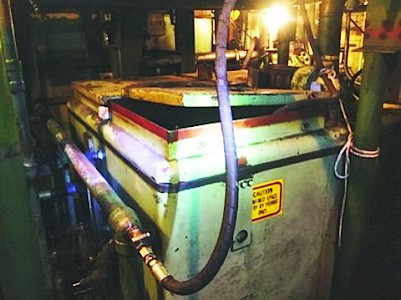
When machine parts and the lubricant protecting the machine’s internal surfaces are exposed to contamination, it is like pouring gasoline on a lit fire. The lubricant that should be protecting these metal surfaces is now having to fight against contamination as well. Additives meant to emulsify water, envelope particles, disperse foam, and even improve the lubricant’s viscosity index are now in overdrive trying to compensate for the additional harm caused by incoming contaminants. Over time, the additives will deplete at an increasing rate, and the oil will become less effective at protecting metal surfaces. As the oil becomes more contaminated and finally loses its lubricating characteristics, machine parts will start exhibiting premature wear. When machine parts start to fail, it’s like tipping over the first domino in a row. It only takes one domino falling to catalyze a chain reaction down the line and cause the rest to fall. Protecting all equipment down the line is critical. You cannot just protect the critical gearbox or expensive bearing from contaminants while leaving the oil reservoir that is feeding the system in a dark wet corner with dust and debris piled on it. I have seen this more times than not-where the components of the machine are modified, protected and clean from contamination, but the oil reservoir feeding the equipment is neglected. It’s important to consider the state of the entire lubrication system. Next time you can, walk the length of a system at your facility and verify that every component down the line is being protected from contamination ingression. The last thing any company wants is machine failure that could lead to downtime and loss of production.
Water Contamination
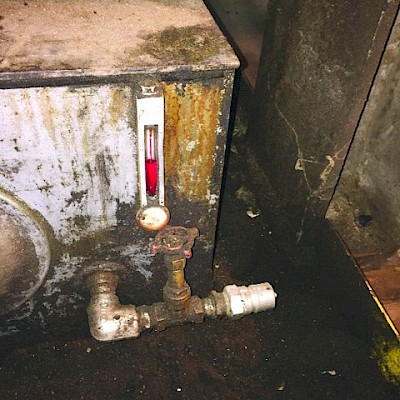
Throughout my years, I've worked with many different industries. The most common lubricant or machine contaminant I have found is water. This is likely because water is used throughout the process in almost every industry. Water is used for cooling machines, cooling the oil in machines, mixing with products and cleaning the equipment and facility. Of course, water can also come from rain, snow, or condensation from humidity. When equipment heats up then cools down, condensation will start to form in the headspace of the equipment. Over time, that condensation adds up and we all know what happens when you mix water, heat, air and metal. The oil will oxidize quickly, eventually destroying the lubricant and the equipment if left untreated.
“Water will find a way” Keep standing water away from machine parts. Do not let a small water leak or containment drain problem destroy machine parts.
Figure 4. “Water will find a way” Keep standing water away from machine parts. Do not let a small water leak or containment drain problem destroy machine parts.
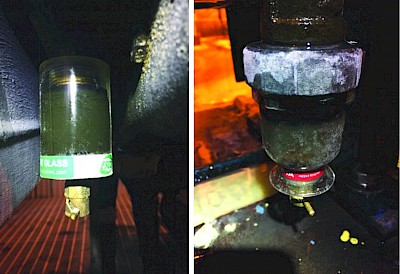
How to Detect Water Buildup
One way to monitor equipment for water buildup is to utilize bottom sediment and water bowl (BS&W Bowl). This is a clear, often cylindrical sight glass that is installed on the bottom side of the oil reservoir or lowest drain, allowing water and other contaminants to naturally settle inside the cylinder for quick visual inspections. Not only does the BS&W bowl allow you to visually inspect what is happening inside the reservoir or sump, but it often has a valve that allows you to drain off or exclude any water or sludge that may have accumulated over time. I would recommend installing a BS&W bowl on all large reservoirs, especially reservoirs utilizing an oil cooling system. These oil cooling systems are the most common source of water contamination on large systems. I always recommend that plants have all oil cooling systems on a routine changeout. Some might think this is excessive, but spending a little bit of time and money is pennies compared to what happens if water is introduced into the system. Cooling systems will start rusting from the inside and eventually, water will start leaking into the oil reservoir or sump, contaminating the oil. With no way of being able to perform a visual inspection on oil coolers, using a BS&W bowl on the oil reservoir can allow you to catch a leak and exclude water before it becomes catastrophic.
Managing and Eliminating Water Contamination
Water is used throughout the process in almost every industry, so figuring out ways to manage water is important. Some of the ways I have seen water enter machine parts almost seems impossible. I like to say, “water will find a way.” Modifying, building barricades, training your staff and making sure equipment seals and gaskets are fresh and tight are all measures you can take that will help exclude water from the system altogether. You should also begin a “No Leak” initiative and fix all the seal water leaks or any other water leaks throughout the plant. Make sure water drains are clear of any debris so water does not pool around and make contact with machine parts. Seal water and cooling water is important to the process and is what helps us protect our equipment. Performing routine leak inspections on all water lines and fixing any leaks will help exclude water from entering the equipment. Some machine parts have oil spill containment underneath to catch spilt oil. What I have noticed is that most of these machines also have cooling water running to the shaft. The cooling water is usually not contained and is either leaking onto machine parts or leaking into the containment underneath and eventually filling the containment with water. Without draining the containment, the water will just sit and eventually find a way into machine parts and will also begin rusting base mounts. Even worse, if there is an actual oil leak, the oil will drain into the containment mixed with water and overflow, creating an environmental concern. Try to exclude all water contact with machine parts except for necessary washdowns.
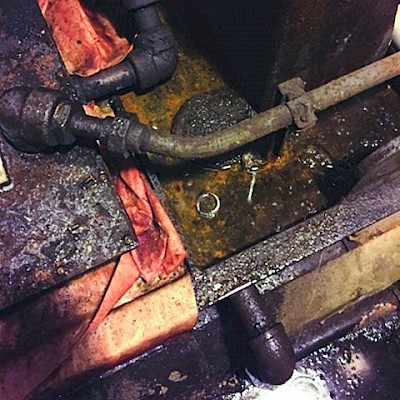
Performing washdowns on machine parts is tricky. We want to keep our equipment clean without contaminating the lubricant in the process. I cannot tell you how much damage I have seen from people spraying down equipment. Training and machine guarding is the best line of defence. Anyone spraying down equipment can cause damage if they don’t know what to spray or how to spray; this is why training is so important for anyone holding a hose. The last thing you want is a 100 HP motor being sprayed down with a high-pressure hose. Adding modifications like spray shields on or around the equipment is another way to stop water from entering machine parts during washdowns. Installing wash down caps on breathers and making sure all gaskets are sealed tight is also important on oil reservoirs in heavy washdown or water prone areas.
Water can enter the system from a plethora of outside sources, but water can also come from within. Condensation is another contamination problem that is often overlooked. Left unchecked, it can be a silent killer inside equipment that is in use as well as equipment not in use. Condensation is generated from humid air inside the oil reservoir or bearing housing during temperature swings. When hot, humid air cools down, the water molecules turn into water drops on interior surfaces.
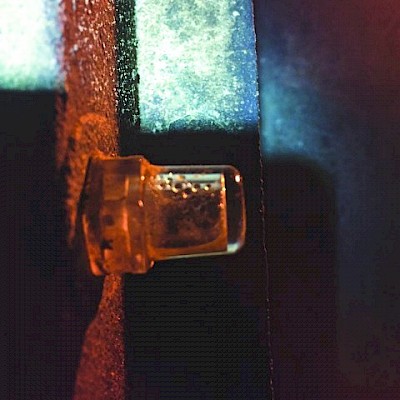
The water droplets form on the unsubmerged areas of the reservoir housing and, when heavy enough, drop or slide into the oil. This is where a BS&W bowl can be a lifesaver. The BS&W bowl will give you an indication that there is excessive water present, and you can drain it off right away. On equipment that might be stored for extended amounts of time, it is often recommended to fill the reservoir with the recommended oil to the top. This will prevent condensation from forming and will inhibit rusting while in storage. You should also ensure that the equipment is sealed with plugs to prevent air from entering during storage. When reservoirs are filled, you should always label the equipment with “Full” or “Drain Before Using” so that the next person can identify that the reservoir is full before the installation. Using desiccant breathers is another way to control the amount of moisture being pulled in and out of the machine during normal operation. Some machines are in high-humidity areas and should have desiccant breathers installed to minimize these airborne contaminants from entering.
If condensation is uncontrollable, then using a filter with water capturing capabilities might be the route to take. Filters and dehydrators can be used for removing water from the oil in the system and may be effective at preventing subsequent failure if done quickly enough. Otherwise, if water is inside the system for too long, it is likely to cause damage. As I said at the beginning, eliminating the contamination problem before it enters the system is always cheaper than having to remove it, so focus on exclusion first and use removal techniques only if moisture cannot be prevented from entering the system.
Solid Contamination
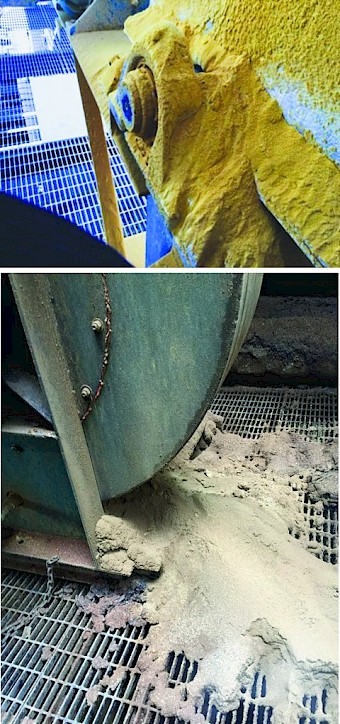
Solid contamination is easily preventable with just a few easy modifications, training and corrections. Solid contaminants can enter machine parts and reservoirs through a variety of pathways or points on equipment. They can even exist in machine parts from the factory. Here’s a word of advice: always flush equipment before installation or during the commissioning process and shortly after first start-up. Metal pieces produced during the manufacturing process could be stuck inside the reservoir housing, gears, or bearings. Flushing the reservoir will hopefully remove any large metal fragments trapped inside. Using magnetic plugs is also a great way of visually inspecting the ferrous metal concentration built up inside the machine housing. You should also anticipate that wear particles could be generated during early service as machines are running in and you should be filtering them out appropriately.
Managing Particle Buildup
Controlling the amount of contamination on and around machine components should be a top priority. The more contamination you have surrounding your equipment, the more contamination you will have inside it. Product or dust buildup on equipment will also serve to insulate the machine, which can cause excessive heat to be generated. I see it time and time again: customers ask why the particle counts are so high on the oil analysis reports. During my investigation, I walk along the affected equipment and notice product piled high around the machinery and blowing everywhere because of a compromised fan duct or a broken conveyor belt dropping product from above. These are all things that can be fixed or prevented. Recalling the “domino effect” I mentioned previously when product or dirt is allowed to become airborne and blows around everywhere, it’s likely that multiple pieces of equipment have now become contaminated. A little oversight and simple proactive repairs can prevent a small hole or busted conveyor from belt turning into a catastrophic shutdown. Installing covers or proper ventilation will help prevent contaminants from building up on machine parts. Performing normal housekeeping on equipment is essential to effective contaminant exclusion. This includes making sure debris does not pile up around fill ports, breather ports and hatches. When filling or inspecting equipment, dirt and debris that are allowed to pile up around these ingression points can easily fall into the reservoir or onto a lubricated surface. Keeping these areas clear of possible contaminants greatly reduces the risk of ingression during regular maintenance and inspections. Atmospheric conditions are hard to control because they can change with the drop of a hat. You cannot predict when the next water line will bust, or the fan duct will pop a hole. You can protect against these unforeseen problems by having systems in place to protect your equipment before and during these failures and by being creative and proactive when thinking about the modifications needed to protect your equipment. Contamination exclusion does not have to be hard or expensive. It takes pre-planning and a willingness to protect machine parts from contamination. Remember, taking the necessary steps to protect equipment from contamination will pay off in the long run and prevent that first domino from ever falling.
